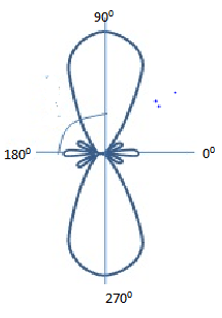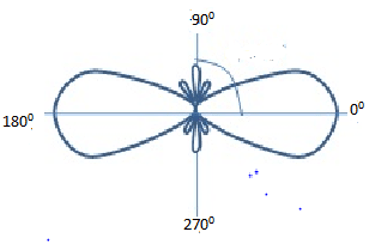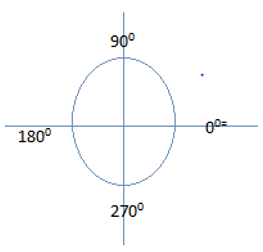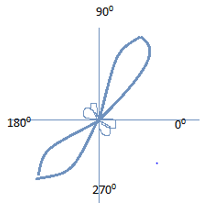This set of Antennas Multiple Choice Questions & Answers (MCQs) focuses on “Broadside Array”.
1. In Broadside array the maximum radiation is directed with respected to the array axis at an angle____
a) 90°
b) 45°
c) 0°
d) 180°
View Answer
Explanation: In a Broadside array the maximum radiated is directed towards the normal to the axis of the array. So it is at angle 90°. In the end-fire array maximum radiation is along the axis of the array.
2. What is the phase excitation difference for a broadside array?
a) 0
b) π/2
c) π
d) 3π/2
View Answer
Explanation: The maximum array factor occurs when \(\frac{sin \frac{Nφ}{2}}{\frac{Nφ}{2}}\) maximum that is \(\frac{Nφ}{2}=0.\) And φ=kdcosθ+β
=> kdcosθ+β=0 For a broadside maximum radiation is normal to axis of array so θ=90
=> β=0
3. Which of the following statements is false regarding a broadside array?
a) The maximum radiation is normal to the axis of the array
b) Must have same amplitude excitation but different phase excitation among different elements
c) The spacing between elements must not equal to the integral multiples of λ
d) The phase excitation difference must be equal to zero
View Answer
Explanation: Since the phase excitation difference is zero it means that all are equally excited with same phase. In a Broadside array the maximum radiated is directed towards the normal to the axis of the array. The spacing between elements is not equal to integral multiples of λ to avoid grating lobes.
4. Which of the following cannot be the separation between elements in a broadside array to avoid grating lobes?
a) 4λ/2
b) λ/2
c) 3λ/2
d) 5λ/2
View Answer
Explanation: The spacing between elements should not equal to integral multiples of λ to avoid grating lobes. The option 4λ/2=2λ
So when d=2λ grating lobes occurs which means maxima are found at other angles also. So this is not a desired spacing.
5. Find the value θn at which null occurs for an 8-element broadside array with spacing d.
a) \(cos^{-1}\frac{λn}{Nd}\)
b) \(sin^{-1}\frac{λn}{Nd}\)
c) \(cos^{-1}\frac{2λn}{Nd}\)
d) \(sin^{-1}\frac{2λn}{Nd}\)
View Answer
Explanation: Nulls occurs when array factor \(AF=\frac{sin \frac{Nφ}{2}}{\frac{Nφ}{2}} = 0\)
⇨ \(sin\frac{Nφ}{2} = 0 =>\frac{Nφ}{2}=±nπ \,and\, φ=kdcosθ+β=kdcosθ_n=\frac{2π}{λ} dcosθ_n\)
⇨ Null occurs at \(θ_n=cos^{-1}\frac{λn}{Nd}\)
6. What would be the directivity of a linear broadside array in dB consisting 5 isotropic elements with element spacing λ/4?
a) 9.37
b) 3.97
c) 6.53
d) 3.79
View Answer
Explanation: Directivity \(D=\frac{2Nd}{λ}=\frac{2×5×\frac{λ}{4}}{λ}=2.5\)
D (dB) = 10log2.5=3.97 dB
7. In a broadside array all the elements must have equal ______ excitation with similar amplitude excitations to get maximum radiation.
a) Phase
b) Frequency
c) Voltage
d) Current
View Answer
Explanation: Since the phase excitation difference is zero it means that all are equally excited with same phase. So in order to get maximum radiation it should have equal phase excitations along with similar amplitude excitations.
8. The directivity of a linear broadside array with half wave length spacing is equal to _____
a) Unity
b) Zero
c) Half of the number of elements present in array
d) Number of elements present in array
View Answer
Explanation: The directivity of N isotropic elements with spacing d is given by
Directivity \(D=\frac{2Nd}{λ} \)
⇨ \(D=\frac{2Nd}{λ}=\frac{2Nλ/2}{λ}=N\)
9. Which of the following is false regarding a linear broadside array with 2 elements and spacing λ?
a) Directivity = 6.02 dB
b) No grating lobes are present
c) Nulls occur at \(cos^{-1}\frac{1}{2} \)
d) The maxima occurs normal to the axis of array and also at other angles
View Answer
Explanation: Since the spacing between elements is an integral multiple of λ (n=1), grating lobes occurs.
Directivity \(D=\frac{2Nd}{λ}=4=6.02dB\)
⇨ Null occurs at \(θ_n=cos^{-1}\frac{λn}{Nd}=cos^{-1}\frac{1}{2} \)
10. What is the radiation pattern of a broadside array when array element axis coincides with the 0° line?
a) 
b)
c)
d)
View Answer
Explanation: In a Broadside array the maximum radiated is directed towards the normal to the axis of the array. Broadside array is a bidirectional antenna and when axis coincides with 00 then maximum radiation is at 90°.

Sanfoundry Global Education & Learning Series – Antennas.
To practice all areas of Antennas, here is complete set of 1000+ Multiple Choice Questions and Answers.
If you find a mistake in question / option / answer, kindly take a screenshot and email to [email protected]
- Check Electrical Engineering Books
- Practice Electrical Engineering MCQs
- Apply for Electronics & Communication Engineering Internship
- Apply for Electrical Engineering Internship
- Check Antenna Books
